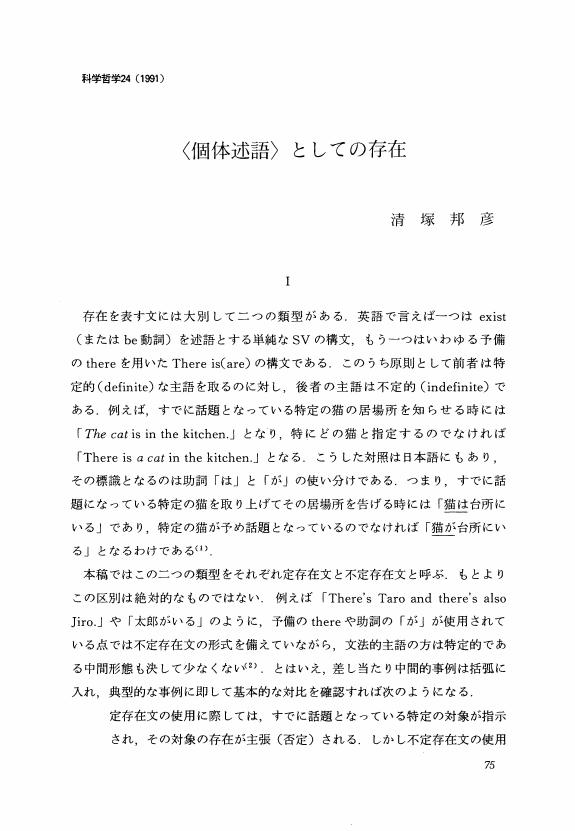- 著者
- 清塚 邦彦
- 出版者
- 山形大学
- 雑誌
- 山形大学人文学部研究年報
- 巻号頁・発行日
- vol.1, pp.37-64, 2004-02-25
以下において検討を加えたいのは,ネルソン・グッドマンが『芸術の言語』(第2版,1976年 ― 引用の際にはLAと略記)をはじめとする著作の中で提示した絵画に関する記号論的分析であり,特に,絵による描写・再現の働きについての分析である。グッドマンの記号論については,「例示(exemplification)」の概念に関わる部分については別稿(清塚[1999a])において詳細な検討を行った。今回の論考は,それと対をなすrepresentationの概念を主題とする続編に当たるものである。この主題についてはすでに別稿(清塚[2002])において,やや異なる文脈の中で部分的な形で紹介・検討を加えたことがあるが,本稿の課題は,絵による描写・再現と関わるグッドマンの理論をより完全な形で紹介し,それに対する修正提案の方向を明確化することにある。
7 0 0 0 IR 写真を通して物を見ること : K・L・ウォルトンの透明性テーゼをめぐって
- 著者
- 清塚 邦彦 キヨズカ クニヒコ Kiyozuka Kunihiko
- 出版者
- 山形大学
- 雑誌
- 山形大學紀要. 人文科學 (ISSN:05134641)
- 巻号頁・発行日
- vol.15, no.2, pp.19-50(302-271), 2003-02-17
In a series of papers, Kendall L. Walton argued that photographs are like mirrors, glasses, telescopes and microscopes, in that they function as "aids to vision" and that, in this respect, they are sharply contrasted with hand-made pictures, such as drawings and paintings. Walton expressed this point by saying that photographs are "transparent pictures" while hand-made pictures are not. This I call "transparency thesis". This is an elaborated form of a widely held opinion that photographs are intrinsically realistic because of their mechanical origin. In this paper, I examine objections raised against Walton's thesis and argue that the thesis is still a promising hypothesis about the nature of photographs as well as the concept of perception in general.
- 著者
- 清塚 邦彦
- 出版者
- 東北哲学会
- 雑誌
- 東北哲学会年報 (ISSN:09139354)
- 巻号頁・発行日
- no.23, pp.81-92, 2007-05-10
4 0 0 0 ネルソン・グッドマンの記号論 : 例示の概念を中心に
- 著者
- 清塚 邦彦
- 出版者
- 山形大学
- 雑誌
- 山形大學紀要. 人文科學 (ISSN:05134641)
- 巻号頁・発行日
- vol.14, no.2, pp.37-67, 1999-01-29
- 著者
- 清塚 邦彦
- 出版者
- 東北哲学会
- 雑誌
- 東北哲学会年報 (ISSN:09139354)
- 巻号頁・発行日
- vol.23, pp.81-92, 2007-05-10 (Released:2018-02-28)
2 0 0 0 確定記述による直接指示 : ドネランの区別について
- 著者
- 清塚 邦彦
- 出版者
- 科学基礎論学会
- 雑誌
- 科学基礎論研究 (ISSN:00227668)
- 巻号頁・発行日
- vol.77, pp.155-162, 1991
1 0 0 0 OA 絵画的な描写について:哲学的分析
- 著者
- 清塚 邦彦
- 出版者
- 山形大学
- 雑誌
- 山形大学紀要. 人文科学 = Bulletin of Yamagata University. Humanities
- 巻号頁・発行日
- vol.15, no.1, pp.41(268)-74(235), 2002-02-15
This paper is a sketch for the philosophical theory of pictorial representation. After introducing the theme of pictorial representation, I shall divide my arguments into two parts. The first part (sec.2-4) contains a series of critiques against ”eliminativist” theories of pictorial representation. By ”eliminativism” I mean those theories which do not recognize the factuality of perception peculiar to pictures at face value. I criticize three theories in particular as specimens of eliminativism: Illusion theory, resemblance theory and convention theory (or semiotic theory). In the second part (sec.5-6), I give an outline of an anti-elimitativist theory of pictorial representation. The theory insists on two points, each of which forms, respectively, a ”natural” and an ”artificial” aspect of the concept of pictorial representation. The first point is that picture perception (perception of images in pictures) is grounded on the twofold operation of the natural abilities of perceptual recognition at a subpersonal level. When we see a picture of a horse, the fact of our looking at the picture triggers, at a sub-personal level, not only the perceptual ability to recognize a plain surface but also the perceptual ability to recognize a horse. As a result, we get a twofold visual experience: what we see is a plain surface of course, but in seeing it, we cannot but have an impression that it is as if we were looking at a horse. This kind of experience is not to be dismissed as mere illusion. It is a natural and normal product of our senses. The second point is that in order that images in pictures get peculiarly representational character, they must be combined with what R.Wollheim called ”standard of correctness”. When we see a natural object (say, a stump in the woods) that happens to look like a bear, we do not say that it ”represents” a bear. It can only be said to ”look like” a bear. But when we see a bear in a picture, we not only say it looks like a bear, but also say that it is, or ”represents”, a bear. And, if someone says that it represents something else, we think that at least either of us must be wrong. Judgements about the representational content of a picture obeys a certain standard which dictates that some judgements are correct and others not. Elucidation of the nature of such standards of correctness forms another essential part of the theory of pictorial representation.
1 0 0 0 IR 絵画的な描写について--哲学的分析
- 著者
- 清塚 邦彦
- 出版者
- 山形大学
- 雑誌
- 山形大学紀要 人文科学 (ISSN:05134641)
- 巻号頁・発行日
- vol.15, no.1, pp.268-235, 2002-02
This paper is a sketch for the philosophical theory of pictorial representation. After introducing the theme of pictorial representation, I shall divide my arguments into two parts. The first part (sec.2-4) contains a series of critiques against "eliminativist" theories of pictorial representation. By "eliminativism" I mean those theories which do not recognize the factuality of perception peculiar to pictures at face value. I criticize three theories in particular as specimens of eliminativism: Illusion theory, resemblance theory and convention theory (or semiotic theory). In the second part (sec.5-6), I give an outline of an anti-elimitativist theory of pictorial representation. The theory insists on two points, each of which forms, respectively, a "natural" and an "artificial" aspect of the concept of pictorial representation. The first point is that picture perception (perception of images in pictures) is grounded on the twofold operation of the natural abilities of perceptual recognition at a subpersonal level. When we see a picture of a horse, the fact of our looking at the picture triggers, at a sub-personal level, not only the perceptual ability to recognize a plain surface but also the perceptual ability to recognize a horse. As a result, we get a twofold visual experience: what we see is a plain surface of course, but in seeing it, we cannot but have an impression that it is as if we were looking at a horse. This kind of experience is not to be dismissed as mere illusion. It is a natural and normal product of our senses. The second point is that in order that images in pictures get peculiarly representational character, they must be combined with what R.Wollheim called "standard of correctness". When we see a natural object (say, a stump in the woods) that happens to look like a bear, we do not say that it "represents" a bear. It can only be said to "look like" a bear. But when we see a bear in a picture, we not only say it looks like a bear, but also say that it is, or "represents", a bear. And, if someone says that it represents something else, we think that at least either of us must be wrong. Judgements about the representational content of a picture obeys a certain standard which dictates that some judgements are correct and others not. Elucidation of the nature of such standards of correctness forms another essential part of the theory of pictorial representation.
1 0 0 0 OA 像と模像 : 絵画的描写の概念をめぐって
- 著者
- 清塚 邦彦
- 出版者
- 東北哲学会
- 雑誌
- 東北哲学会年報 (ISSN:09139354)
- 巻号頁・発行日
- vol.15, pp.28-44, 1999-05-20 (Released:2018-02-28)
1 0 0 0 OA 確定記述による直接指示 ドネランの区別について
- 著者
- 清塚 邦彦
- 出版者
- 科学基礎論学会
- 雑誌
- 科学基礎論研究 (ISSN:00227668)
- 巻号頁・発行日
- vol.20, no.3, pp.155-162, 1991-12-25 (Released:2009-09-04)
- 参考文献数
- 25
1 0 0 0 OA 近位説と遠位説:クワインの観察文理論に対するデイヴィドソンの批判について
- 著者
- 清塚 邦彦
- 出版者
- 日本科学哲学会
- 雑誌
- 科学哲学 (ISSN:02893428)
- 巻号頁・発行日
- vol.35, no.2, pp.15-28, 2002-11-10 (Released:2009-05-29)
- 参考文献数
- 20
In "Meaning, Truth and Evidence" (1990), Davidson took issue on Quine's empiricist theory of meaning and knowledge. The point at issue was the concept of 'stimulus meaning' which Quine defined in physiological terms. Davidson argued that physiology should not matter much either in the theory of meaning or in epistemology. This criticism was pertinent to Quine's theory of meaning (Quine eventually abandoned the concept of 'stimulus meaning' itself). But, as I shall argue, it had little effect on Quine's epistemology: though it prompted minor changes on Quine's part, Quine's physiological bent in epistemology was retained, and justifiably, in the face of Davidson's criticism.
1 0 0 0 OA 指示詞の本性と〈自己関係性〉
- 著者
- 清塚 邦彦
- 出版者
- 日本科学哲学会
- 雑誌
- 科学哲学 (ISSN:02893428)
- 巻号頁・発行日
- vol.25, pp.85-98, 1992-11-14 (Released:2009-12-07)
1 0 0 0 OA 〈固体述語〉としての存在
- 著者
- 清塚 邦彦
- 出版者
- 日本科学哲学会
- 雑誌
- 科学哲学 (ISSN:02893428)
- 巻号頁・発行日
- vol.24, pp.75-88, 1991-11-15 (Released:2009-12-07)
1 0 0 0 OA フィクションの哲学―虚構概念の哲学的分析
- 著者
- 清塚 邦彦
- 巻号頁・発行日
- no.28,
1 0 0 0 OA 写真を通して物を見ること : K・L・ウォルトンの透明性テーゼをめぐって
- 著者
- 清塚 邦彦
- 出版者
- 山形大学
- 雑誌
- 山形大学紀要. 人文科学 = Bulletin of Yamagata University. Humanities
- 巻号頁・発行日
- vol.15, no.2, pp.19(302)-50(271), 2003-02-17
In a series of papers, Kendall L. Walton argued that photographs are like mirrors, glasses, telescopes and microscopes, in that they function as ”aids to vision” and that, in this respect, they are sharply contrasted with hand-made pictures, such as drawings and paintings. Walton expressed this point by saying that photographs are ”transparent pictures” while hand-made pictures are not. This I call ”transparency thesis”. This is an elaborated form of a widely held opinion that photographs are intrinsically realistic because of their mechanical origin. In this paper, I examine objections raised against Walton's thesis and argue that the thesis is still a promising hypothesis about the nature of photographs as well as the concept of perception in general.
1 0 0 0 OA ネルソン・グッドマンの贋作論 : 『芸術の言語』第3章の分析
- 著者
- 清塚 邦彦
- 出版者
- 山形大学
- 雑誌
- 山形大学紀要. 人文科学 = Bulletin of Yamagata University. Humanities
- 巻号頁・発行日
- vol.18, no.1, pp.1-39, 2014-02-15
1 0 0 0 OA フィクションの哲学―虚構概念の哲学的分析
- 著者
- 清塚 邦彦
- 出版者
- Tohoku University
- 巻号頁・発行日
- 2016-11-10
要約のみ
1 0 0 0 OA 写真を通して物を見ること : K・L・ウォルトンの透明性テーゼをめぐって
- 著者
- 清塚邦彦
- 出版者
- 山形大学
- 雑誌
- 山形大学紀要(人文科学)
- 巻号頁・発行日
- vol.15, no.2, 2003-02-17
1 0 0 0 IR ネルソン・グッドマンの贋作論 : 『芸術の言語』第3章の分析
- 著者
- 清塚 邦彦
- 出版者
- 山形大学
- 雑誌
- 山形大学紀要. 人文科学 = Bulletin of Yamagata University. Humanities
- 巻号頁・発行日
- vol.18, no.1, pp.1-39, 2014-02-15





